BM563 Operations & Service Management: TESCO Operations Report
VerifiedAdded on 2023/06/13
|12
|3487
|278
Report
AI Summary
This report provides an overview of operations and service management within TESCO, a prominent retail organization. It elaborates on best practices in operations management (OM), including quality management standards, stock control, and information management. The report further analyzes the impact of supply chain management on organizational efficiency, highlighting benefits such as better output, competitive advantage, standardized processes, and improved employee engagement. It also discusses the use of technology, such as big data, artificial intelligence, IoT, and cloud computing, to enhance supply chain management. Finally, the report touches upon the supporting functions of supply chain management and their role in ensuring the success of the organization, emphasizing continuous improvement and the ability to leverage new technologies for better returns management.
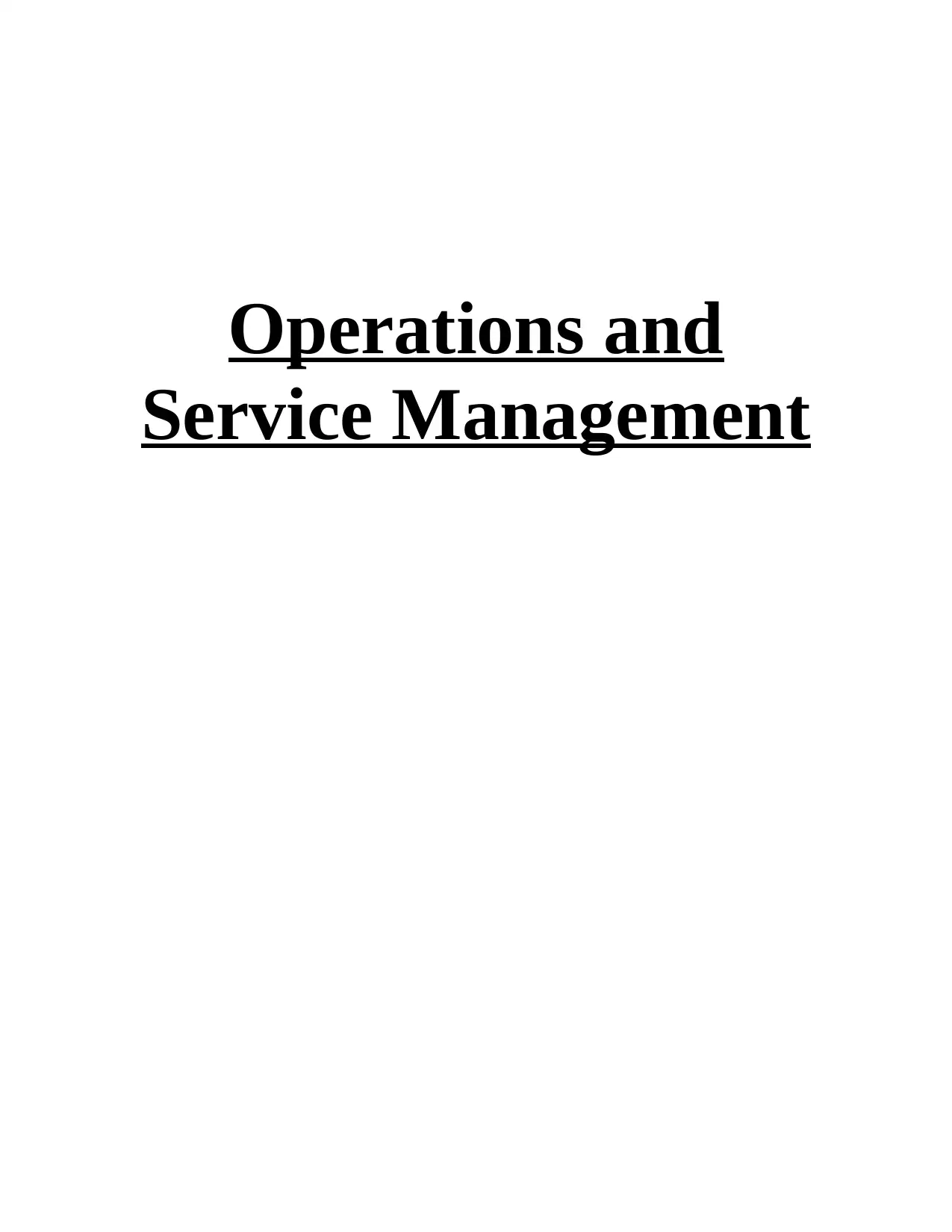
Operations and
Service Management
Service Management
Paraphrase This Document
Need a fresh take? Get an instant paraphrase of this document with our AI Paraphraser
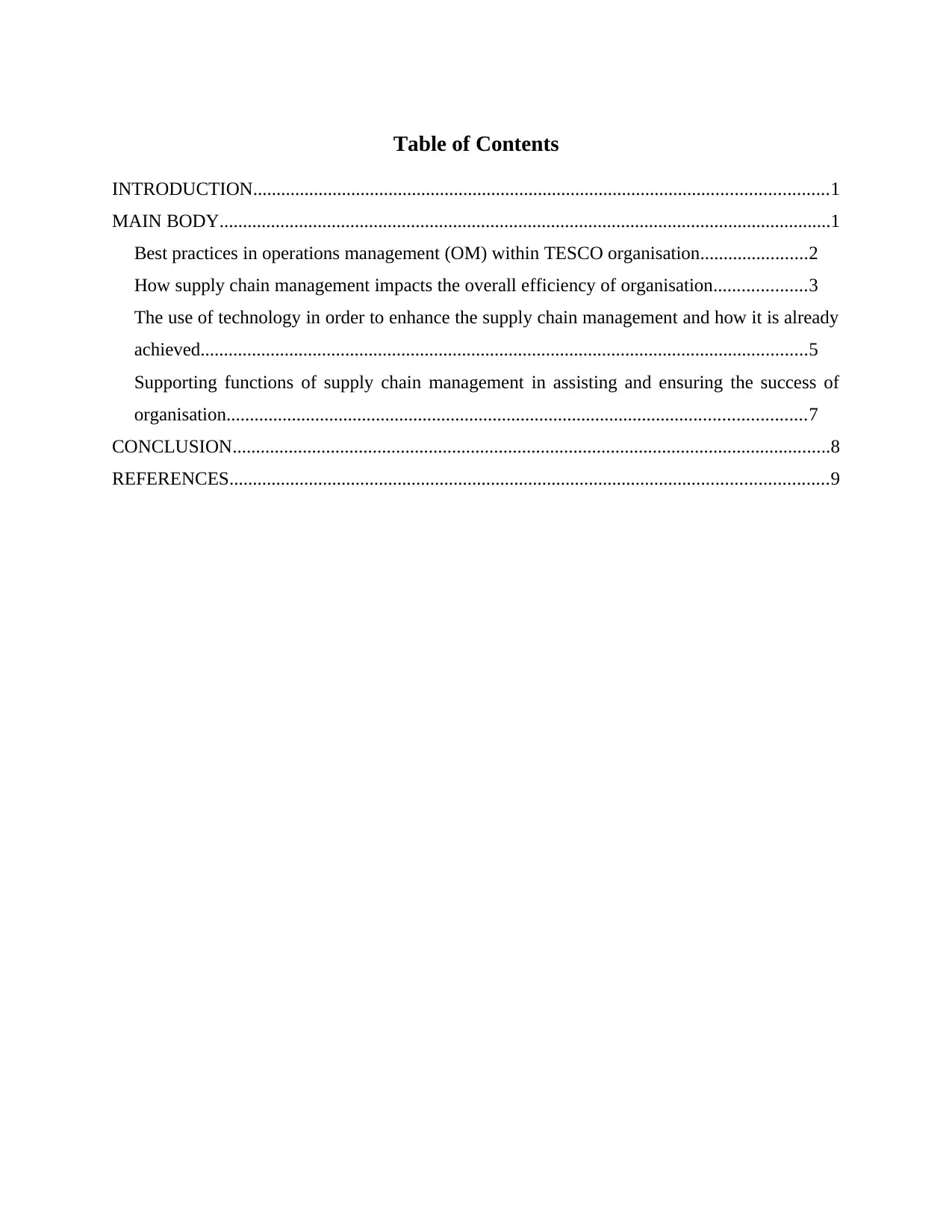
Table of Contents
INTRODUCTION...........................................................................................................................1
MAIN BODY...................................................................................................................................1
Best practices in operations management (OM) within TESCO organisation.......................2
How supply chain management impacts the overall efficiency of organisation....................3
The use of technology in order to enhance the supply chain management and how it is already
achieved..................................................................................................................................5
Supporting functions of supply chain management in assisting and ensuring the success of
organisation............................................................................................................................7
CONCLUSION................................................................................................................................8
REFERENCES................................................................................................................................9
INTRODUCTION...........................................................................................................................1
MAIN BODY...................................................................................................................................1
Best practices in operations management (OM) within TESCO organisation.......................2
How supply chain management impacts the overall efficiency of organisation....................3
The use of technology in order to enhance the supply chain management and how it is already
achieved..................................................................................................................................5
Supporting functions of supply chain management in assisting and ensuring the success of
organisation............................................................................................................................7
CONCLUSION................................................................................................................................8
REFERENCES................................................................................................................................9
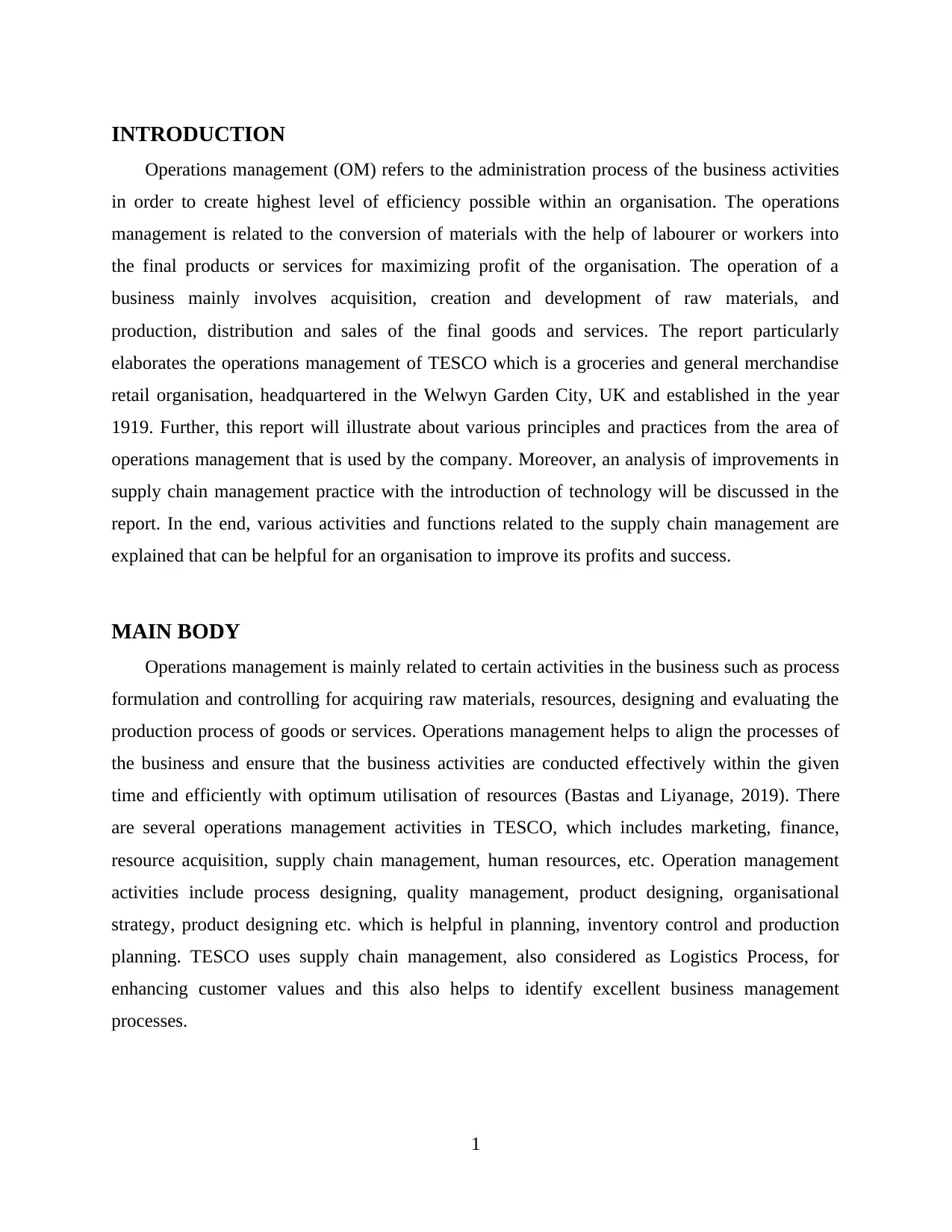
INTRODUCTION
Operations management (OM) refers to the administration process of the business activities
in order to create highest level of efficiency possible within an organisation. The operations
management is related to the conversion of materials with the help of labourer or workers into
the final products or services for maximizing profit of the organisation. The operation of a
business mainly involves acquisition, creation and development of raw materials, and
production, distribution and sales of the final goods and services. The report particularly
elaborates the operations management of TESCO which is a groceries and general merchandise
retail organisation, headquartered in the Welwyn Garden City, UK and established in the year
1919. Further, this report will illustrate about various principles and practices from the area of
operations management that is used by the company. Moreover, an analysis of improvements in
supply chain management practice with the introduction of technology will be discussed in the
report. In the end, various activities and functions related to the supply chain management are
explained that can be helpful for an organisation to improve its profits and success.
MAIN BODY
Operations management is mainly related to certain activities in the business such as process
formulation and controlling for acquiring raw materials, resources, designing and evaluating the
production process of goods or services. Operations management helps to align the processes of
the business and ensure that the business activities are conducted effectively within the given
time and efficiently with optimum utilisation of resources (Bastas and Liyanage, 2019). There
are several operations management activities in TESCO, which includes marketing, finance,
resource acquisition, supply chain management, human resources, etc. Operation management
activities include process designing, quality management, product designing, organisational
strategy, product designing etc. which is helpful in planning, inventory control and production
planning. TESCO uses supply chain management, also considered as Logistics Process, for
enhancing customer values and this also helps to identify excellent business management
processes.
1
Operations management (OM) refers to the administration process of the business activities
in order to create highest level of efficiency possible within an organisation. The operations
management is related to the conversion of materials with the help of labourer or workers into
the final products or services for maximizing profit of the organisation. The operation of a
business mainly involves acquisition, creation and development of raw materials, and
production, distribution and sales of the final goods and services. The report particularly
elaborates the operations management of TESCO which is a groceries and general merchandise
retail organisation, headquartered in the Welwyn Garden City, UK and established in the year
1919. Further, this report will illustrate about various principles and practices from the area of
operations management that is used by the company. Moreover, an analysis of improvements in
supply chain management practice with the introduction of technology will be discussed in the
report. In the end, various activities and functions related to the supply chain management are
explained that can be helpful for an organisation to improve its profits and success.
MAIN BODY
Operations management is mainly related to certain activities in the business such as process
formulation and controlling for acquiring raw materials, resources, designing and evaluating the
production process of goods or services. Operations management helps to align the processes of
the business and ensure that the business activities are conducted effectively within the given
time and efficiently with optimum utilisation of resources (Bastas and Liyanage, 2019). There
are several operations management activities in TESCO, which includes marketing, finance,
resource acquisition, supply chain management, human resources, etc. Operation management
activities include process designing, quality management, product designing, organisational
strategy, product designing etc. which is helpful in planning, inventory control and production
planning. TESCO uses supply chain management, also considered as Logistics Process, for
enhancing customer values and this also helps to identify excellent business management
processes.
1
⊘ This is a preview!⊘
Do you want full access?
Subscribe today to unlock all pages.

Trusted by 1+ million students worldwide
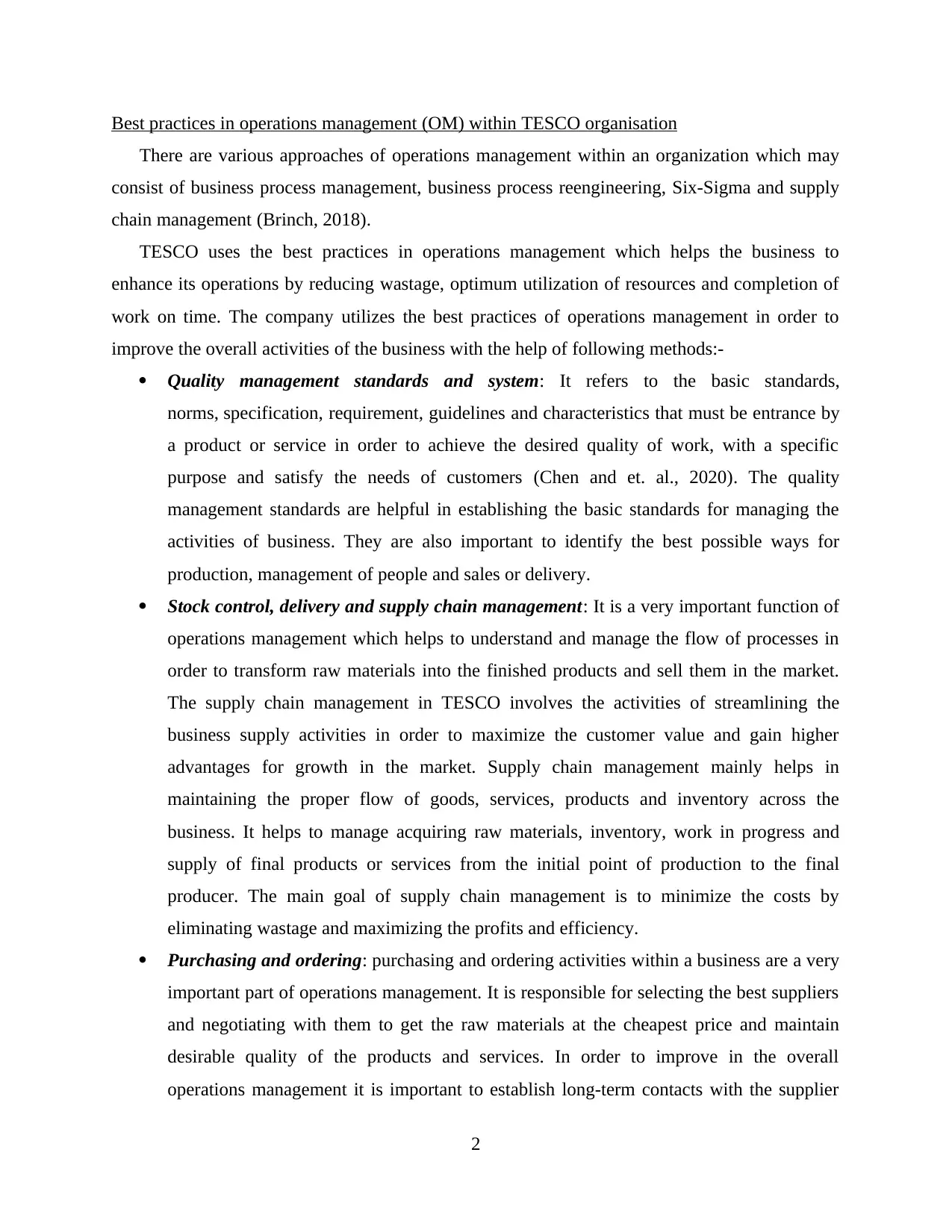
Best practices in operations management (OM) within TESCO organisation
There are various approaches of operations management within an organization which may
consist of business process management, business process reengineering, Six-Sigma and supply
chain management (Brinch, 2018).
TESCO uses the best practices in operations management which helps the business to
enhance its operations by reducing wastage, optimum utilization of resources and completion of
work on time. The company utilizes the best practices of operations management in order to
improve the overall activities of the business with the help of following methods:-
Quality management standards and system: It refers to the basic standards,
norms, specification, requirement, guidelines and characteristics that must be entrance by
a product or service in order to achieve the desired quality of work, with a specific
purpose and satisfy the needs of customers (Chen and et. al., 2020). The quality
management standards are helpful in establishing the basic standards for managing the
activities of business. They are also important to identify the best possible ways for
production, management of people and sales or delivery.
Stock control, delivery and supply chain management: It is a very important function of
operations management which helps to understand and manage the flow of processes in
order to transform raw materials into the finished products and sell them in the market.
The supply chain management in TESCO involves the activities of streamlining the
business supply activities in order to maximize the customer value and gain higher
advantages for growth in the market. Supply chain management mainly helps in
maintaining the proper flow of goods, services, products and inventory across the
business. It helps to manage acquiring raw materials, inventory, work in progress and
supply of final products or services from the initial point of production to the final
producer. The main goal of supply chain management is to minimize the costs by
eliminating wastage and maximizing the profits and efficiency.
Purchasing and ordering: purchasing and ordering activities within a business are a very
important part of operations management. It is responsible for selecting the best suppliers
and negotiating with them to get the raw materials at the cheapest price and maintain
desirable quality of the products and services. In order to improve in the overall
operations management it is important to establish long-term contacts with the supplier
2
There are various approaches of operations management within an organization which may
consist of business process management, business process reengineering, Six-Sigma and supply
chain management (Brinch, 2018).
TESCO uses the best practices in operations management which helps the business to
enhance its operations by reducing wastage, optimum utilization of resources and completion of
work on time. The company utilizes the best practices of operations management in order to
improve the overall activities of the business with the help of following methods:-
Quality management standards and system: It refers to the basic standards,
norms, specification, requirement, guidelines and characteristics that must be entrance by
a product or service in order to achieve the desired quality of work, with a specific
purpose and satisfy the needs of customers (Chen and et. al., 2020). The quality
management standards are helpful in establishing the basic standards for managing the
activities of business. They are also important to identify the best possible ways for
production, management of people and sales or delivery.
Stock control, delivery and supply chain management: It is a very important function of
operations management which helps to understand and manage the flow of processes in
order to transform raw materials into the finished products and sell them in the market.
The supply chain management in TESCO involves the activities of streamlining the
business supply activities in order to maximize the customer value and gain higher
advantages for growth in the market. Supply chain management mainly helps in
maintaining the proper flow of goods, services, products and inventory across the
business. It helps to manage acquiring raw materials, inventory, work in progress and
supply of final products or services from the initial point of production to the final
producer. The main goal of supply chain management is to minimize the costs by
eliminating wastage and maximizing the profits and efficiency.
Purchasing and ordering: purchasing and ordering activities within a business are a very
important part of operations management. It is responsible for selecting the best suppliers
and negotiating with them to get the raw materials at the cheapest price and maintain
desirable quality of the products and services. In order to improve in the overall
operations management it is important to establish long-term contacts with the supplier
2
Paraphrase This Document
Need a fresh take? Get an instant paraphrase of this document with our AI Paraphraser
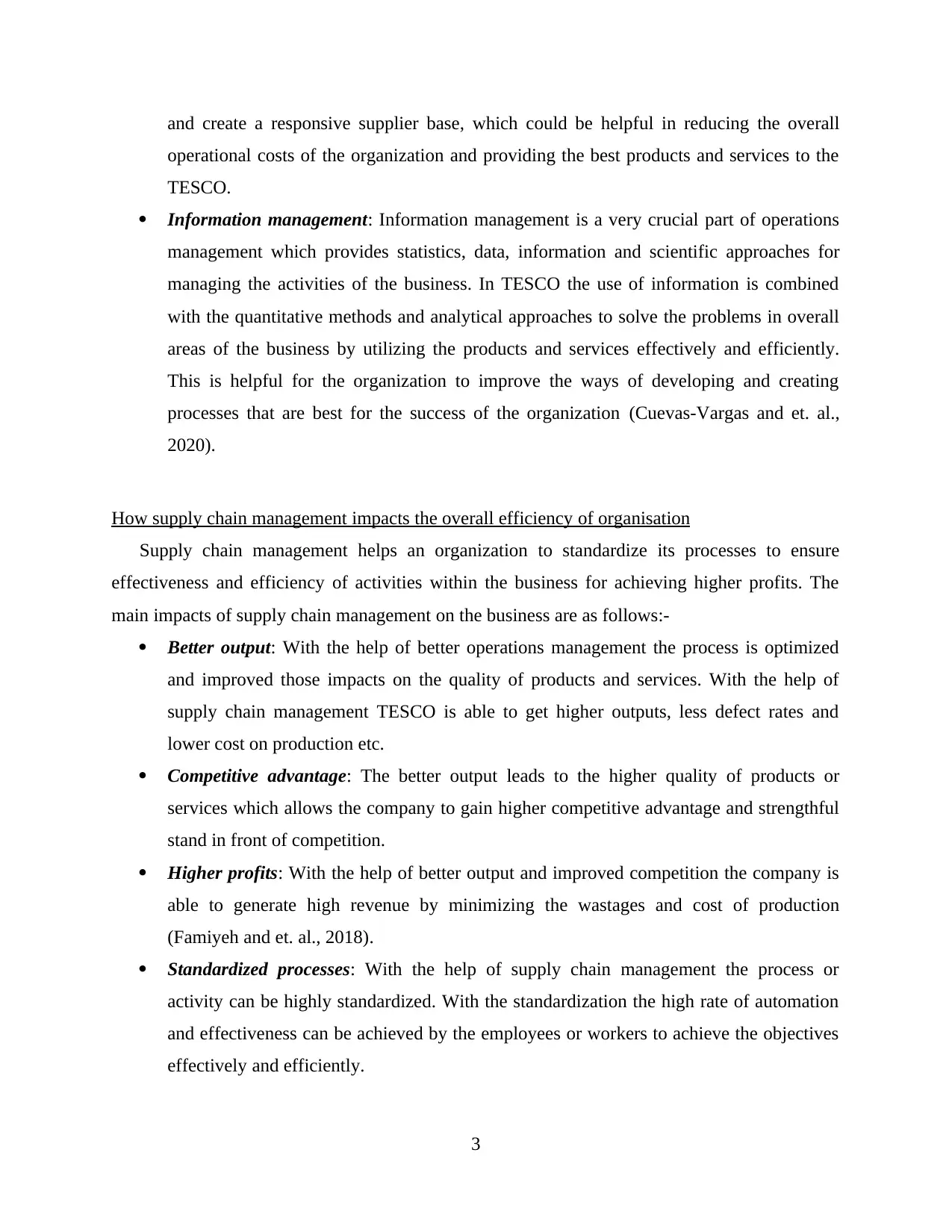
and create a responsive supplier base, which could be helpful in reducing the overall
operational costs of the organization and providing the best products and services to the
TESCO.
Information management: Information management is a very crucial part of operations
management which provides statistics, data, information and scientific approaches for
managing the activities of the business. In TESCO the use of information is combined
with the quantitative methods and analytical approaches to solve the problems in overall
areas of the business by utilizing the products and services effectively and efficiently.
This is helpful for the organization to improve the ways of developing and creating
processes that are best for the success of the organization (Cuevas-Vargas and et. al.,
2020).
How supply chain management impacts the overall efficiency of organisation
Supply chain management helps an organization to standardize its processes to ensure
effectiveness and efficiency of activities within the business for achieving higher profits. The
main impacts of supply chain management on the business are as follows:-
Better output: With the help of better operations management the process is optimized
and improved those impacts on the quality of products and services. With the help of
supply chain management TESCO is able to get higher outputs, less defect rates and
lower cost on production etc.
Competitive advantage: The better output leads to the higher quality of products or
services which allows the company to gain higher competitive advantage and strengthful
stand in front of competition.
Higher profits: With the help of better output and improved competition the company is
able to generate high revenue by minimizing the wastages and cost of production
(Famiyeh and et. al., 2018).
Standardized processes: With the help of supply chain management the process or
activity can be highly standardized. With the standardization the high rate of automation
and effectiveness can be achieved by the employees or workers to achieve the objectives
effectively and efficiently.
3
operational costs of the organization and providing the best products and services to the
TESCO.
Information management: Information management is a very crucial part of operations
management which provides statistics, data, information and scientific approaches for
managing the activities of the business. In TESCO the use of information is combined
with the quantitative methods and analytical approaches to solve the problems in overall
areas of the business by utilizing the products and services effectively and efficiently.
This is helpful for the organization to improve the ways of developing and creating
processes that are best for the success of the organization (Cuevas-Vargas and et. al.,
2020).
How supply chain management impacts the overall efficiency of organisation
Supply chain management helps an organization to standardize its processes to ensure
effectiveness and efficiency of activities within the business for achieving higher profits. The
main impacts of supply chain management on the business are as follows:-
Better output: With the help of better operations management the process is optimized
and improved those impacts on the quality of products and services. With the help of
supply chain management TESCO is able to get higher outputs, less defect rates and
lower cost on production etc.
Competitive advantage: The better output leads to the higher quality of products or
services which allows the company to gain higher competitive advantage and strengthful
stand in front of competition.
Higher profits: With the help of better output and improved competition the company is
able to generate high revenue by minimizing the wastages and cost of production
(Famiyeh and et. al., 2018).
Standardized processes: With the help of supply chain management the process or
activity can be highly standardized. With the standardization the high rate of automation
and effectiveness can be achieved by the employees or workers to achieve the objectives
effectively and efficiently.
3
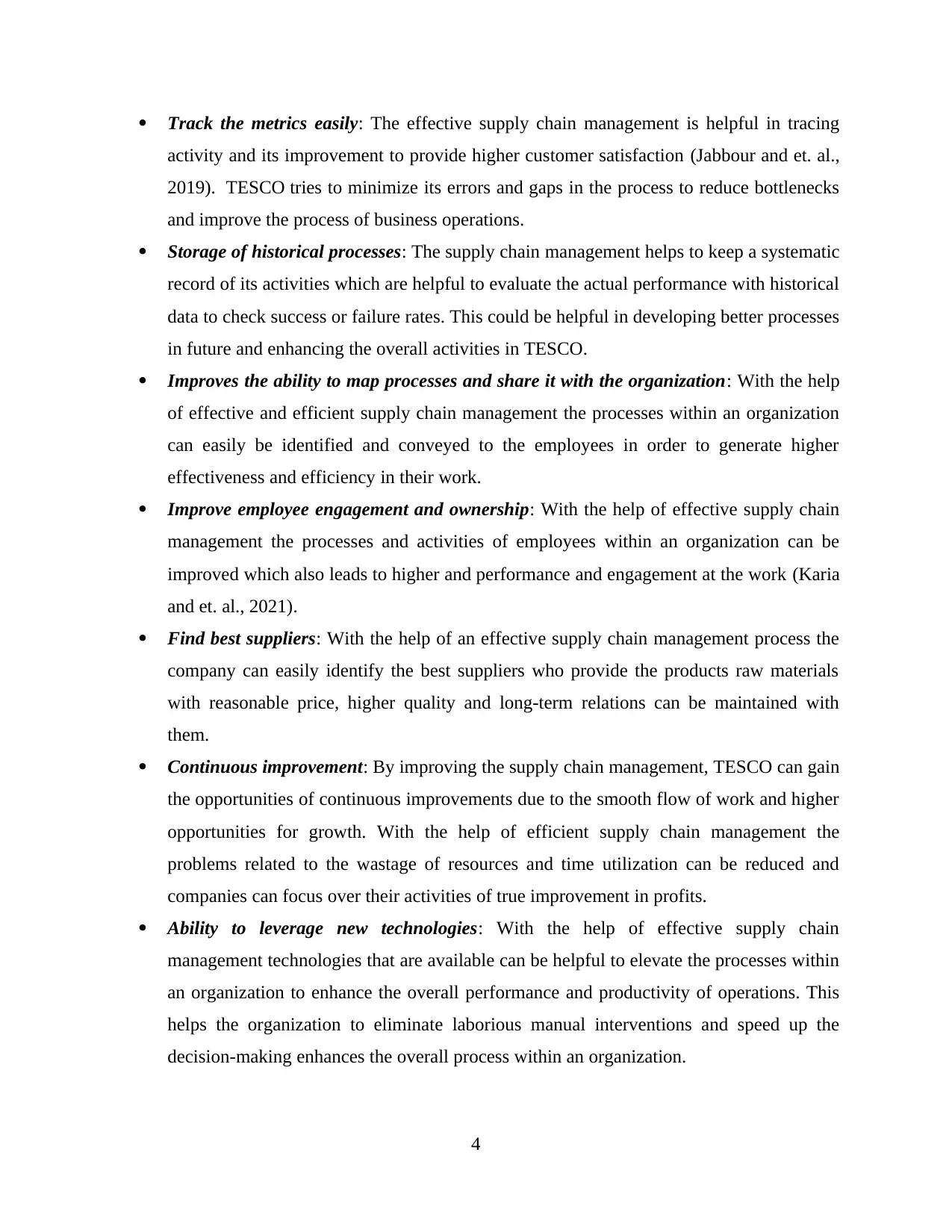
Track the metrics easily: The effective supply chain management is helpful in tracing
activity and its improvement to provide higher customer satisfaction (Jabbour and et. al.,
2019). TESCO tries to minimize its errors and gaps in the process to reduce bottlenecks
and improve the process of business operations.
Storage of historical processes: The supply chain management helps to keep a systematic
record of its activities which are helpful to evaluate the actual performance with historical
data to check success or failure rates. This could be helpful in developing better processes
in future and enhancing the overall activities in TESCO.
Improves the ability to map processes and share it with the organization: With the help
of effective and efficient supply chain management the processes within an organization
can easily be identified and conveyed to the employees in order to generate higher
effectiveness and efficiency in their work.
Improve employee engagement and ownership: With the help of effective supply chain
management the processes and activities of employees within an organization can be
improved which also leads to higher and performance and engagement at the work (Karia
and et. al., 2021).
Find best suppliers: With the help of an effective supply chain management process the
company can easily identify the best suppliers who provide the products raw materials
with reasonable price, higher quality and long-term relations can be maintained with
them.
Continuous improvement: By improving the supply chain management, TESCO can gain
the opportunities of continuous improvements due to the smooth flow of work and higher
opportunities for growth. With the help of efficient supply chain management the
problems related to the wastage of resources and time utilization can be reduced and
companies can focus over their activities of true improvement in profits.
Ability to leverage new technologies: With the help of effective supply chain
management technologies that are available can be helpful to elevate the processes within
an organization to enhance the overall performance and productivity of operations. This
helps the organization to eliminate laborious manual interventions and speed up the
decision-making enhances the overall process within an organization.
4
activity and its improvement to provide higher customer satisfaction (Jabbour and et. al.,
2019). TESCO tries to minimize its errors and gaps in the process to reduce bottlenecks
and improve the process of business operations.
Storage of historical processes: The supply chain management helps to keep a systematic
record of its activities which are helpful to evaluate the actual performance with historical
data to check success or failure rates. This could be helpful in developing better processes
in future and enhancing the overall activities in TESCO.
Improves the ability to map processes and share it with the organization: With the help
of effective and efficient supply chain management the processes within an organization
can easily be identified and conveyed to the employees in order to generate higher
effectiveness and efficiency in their work.
Improve employee engagement and ownership: With the help of effective supply chain
management the processes and activities of employees within an organization can be
improved which also leads to higher and performance and engagement at the work (Karia
and et. al., 2021).
Find best suppliers: With the help of an effective supply chain management process the
company can easily identify the best suppliers who provide the products raw materials
with reasonable price, higher quality and long-term relations can be maintained with
them.
Continuous improvement: By improving the supply chain management, TESCO can gain
the opportunities of continuous improvements due to the smooth flow of work and higher
opportunities for growth. With the help of efficient supply chain management the
problems related to the wastage of resources and time utilization can be reduced and
companies can focus over their activities of true improvement in profits.
Ability to leverage new technologies: With the help of effective supply chain
management technologies that are available can be helpful to elevate the processes within
an organization to enhance the overall performance and productivity of operations. This
helps the organization to eliminate laborious manual interventions and speed up the
decision-making enhances the overall process within an organization.
4
⊘ This is a preview!⊘
Do you want full access?
Subscribe today to unlock all pages.

Trusted by 1+ million students worldwide
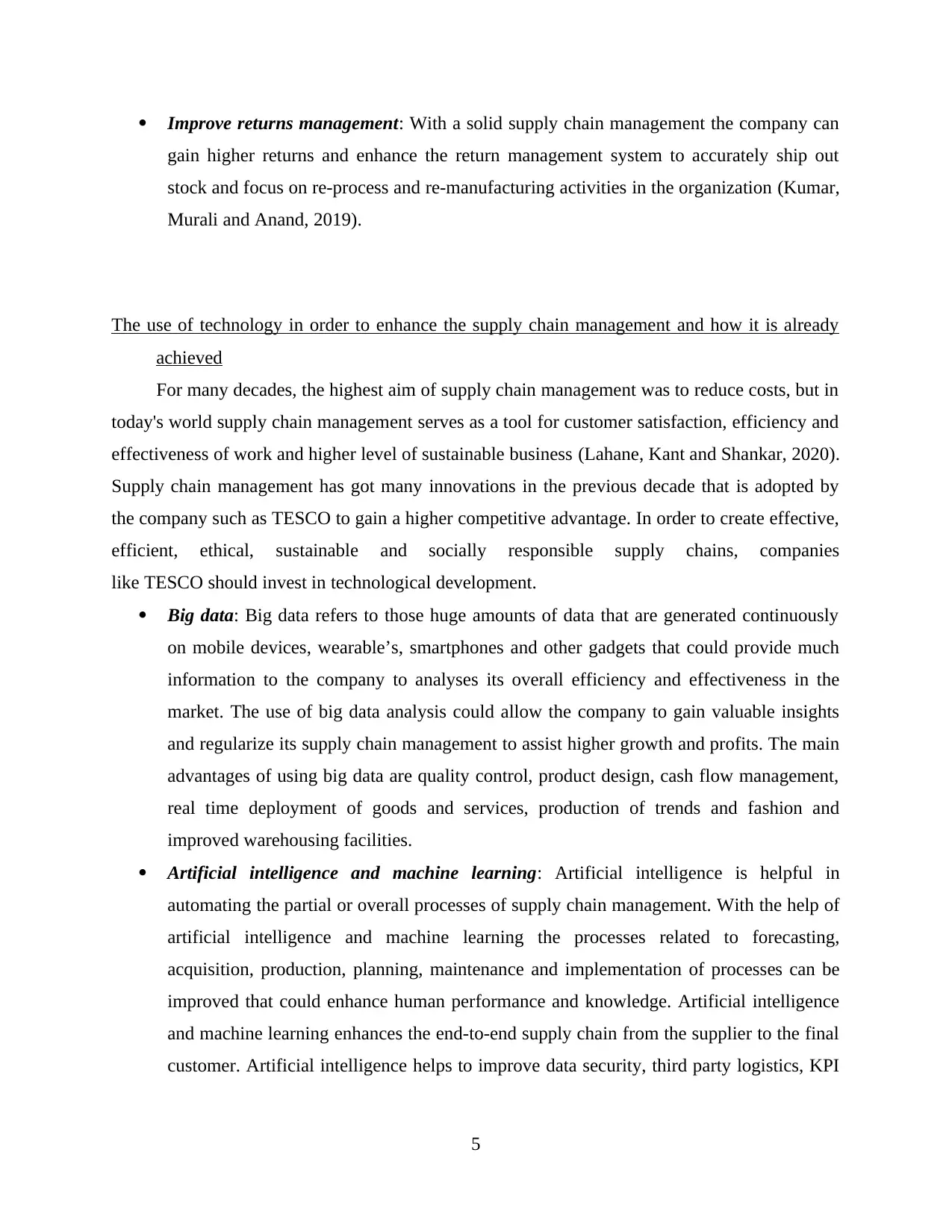
Improve returns management: With a solid supply chain management the company can
gain higher returns and enhance the return management system to accurately ship out
stock and focus on re-process and re-manufacturing activities in the organization (Kumar,
Murali and Anand, 2019).
The use of technology in order to enhance the supply chain management and how it is already
achieved
For many decades, the highest aim of supply chain management was to reduce costs, but in
today's world supply chain management serves as a tool for customer satisfaction, efficiency and
effectiveness of work and higher level of sustainable business (Lahane, Kant and Shankar, 2020).
Supply chain management has got many innovations in the previous decade that is adopted by
the company such as TESCO to gain a higher competitive advantage. In order to create effective,
efficient, ethical, sustainable and socially responsible supply chains, companies
like TESCO should invest in technological development.
Big data: Big data refers to those huge amounts of data that are generated continuously
on mobile devices, wearable’s, smartphones and other gadgets that could provide much
information to the company to analyses its overall efficiency and effectiveness in the
market. The use of big data analysis could allow the company to gain valuable insights
and regularize its supply chain management to assist higher growth and profits. The main
advantages of using big data are quality control, product design, cash flow management,
real time deployment of goods and services, production of trends and fashion and
improved warehousing facilities.
Artificial intelligence and machine learning: Artificial intelligence is helpful in
automating the partial or overall processes of supply chain management. With the help of
artificial intelligence and machine learning the processes related to forecasting,
acquisition, production, planning, maintenance and implementation of processes can be
improved that could enhance human performance and knowledge. Artificial intelligence
and machine learning enhances the end-to-end supply chain from the supplier to the final
customer. Artificial intelligence helps to improve data security, third party logistics, KPI
5
gain higher returns and enhance the return management system to accurately ship out
stock and focus on re-process and re-manufacturing activities in the organization (Kumar,
Murali and Anand, 2019).
The use of technology in order to enhance the supply chain management and how it is already
achieved
For many decades, the highest aim of supply chain management was to reduce costs, but in
today's world supply chain management serves as a tool for customer satisfaction, efficiency and
effectiveness of work and higher level of sustainable business (Lahane, Kant and Shankar, 2020).
Supply chain management has got many innovations in the previous decade that is adopted by
the company such as TESCO to gain a higher competitive advantage. In order to create effective,
efficient, ethical, sustainable and socially responsible supply chains, companies
like TESCO should invest in technological development.
Big data: Big data refers to those huge amounts of data that are generated continuously
on mobile devices, wearable’s, smartphones and other gadgets that could provide much
information to the company to analyses its overall efficiency and effectiveness in the
market. The use of big data analysis could allow the company to gain valuable insights
and regularize its supply chain management to assist higher growth and profits. The main
advantages of using big data are quality control, product design, cash flow management,
real time deployment of goods and services, production of trends and fashion and
improved warehousing facilities.
Artificial intelligence and machine learning: Artificial intelligence is helpful in
automating the partial or overall processes of supply chain management. With the help of
artificial intelligence and machine learning the processes related to forecasting,
acquisition, production, planning, maintenance and implementation of processes can be
improved that could enhance human performance and knowledge. Artificial intelligence
and machine learning enhances the end-to-end supply chain from the supplier to the final
customer. Artificial intelligence helps to improve data security, third party logistics, KPI
5
Paraphrase This Document
Need a fresh take? Get an instant paraphrase of this document with our AI Paraphraser
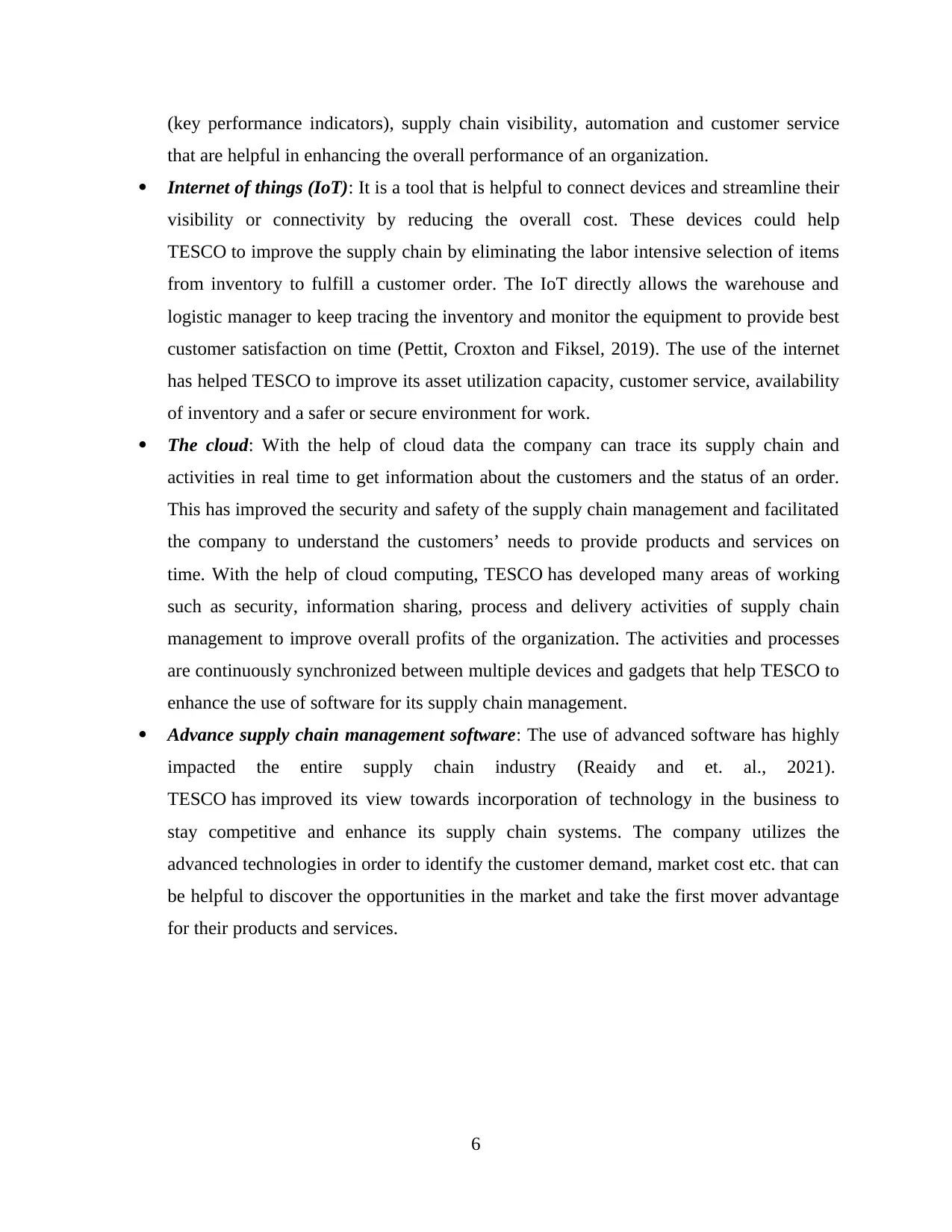
(key performance indicators), supply chain visibility, automation and customer service
that are helpful in enhancing the overall performance of an organization.
Internet of things (IoT): It is a tool that is helpful to connect devices and streamline their
visibility or connectivity by reducing the overall cost. These devices could help
TESCO to improve the supply chain by eliminating the labor intensive selection of items
from inventory to fulfill a customer order. The IoT directly allows the warehouse and
logistic manager to keep tracing the inventory and monitor the equipment to provide best
customer satisfaction on time (Pettit, Croxton and Fiksel, 2019). The use of the internet
has helped TESCO to improve its asset utilization capacity, customer service, availability
of inventory and a safer or secure environment for work.
The cloud: With the help of cloud data the company can trace its supply chain and
activities in real time to get information about the customers and the status of an order.
This has improved the security and safety of the supply chain management and facilitated
the company to understand the customers’ needs to provide products and services on
time. With the help of cloud computing, TESCO has developed many areas of working
such as security, information sharing, process and delivery activities of supply chain
management to improve overall profits of the organization. The activities and processes
are continuously synchronized between multiple devices and gadgets that help TESCO to
enhance the use of software for its supply chain management.
Advance supply chain management software: The use of advanced software has highly
impacted the entire supply chain industry (Reaidy and et. al., 2021).
TESCO has improved its view towards incorporation of technology in the business to
stay competitive and enhance its supply chain systems. The company utilizes the
advanced technologies in order to identify the customer demand, market cost etc. that can
be helpful to discover the opportunities in the market and take the first mover advantage
for their products and services.
6
that are helpful in enhancing the overall performance of an organization.
Internet of things (IoT): It is a tool that is helpful to connect devices and streamline their
visibility or connectivity by reducing the overall cost. These devices could help
TESCO to improve the supply chain by eliminating the labor intensive selection of items
from inventory to fulfill a customer order. The IoT directly allows the warehouse and
logistic manager to keep tracing the inventory and monitor the equipment to provide best
customer satisfaction on time (Pettit, Croxton and Fiksel, 2019). The use of the internet
has helped TESCO to improve its asset utilization capacity, customer service, availability
of inventory and a safer or secure environment for work.
The cloud: With the help of cloud data the company can trace its supply chain and
activities in real time to get information about the customers and the status of an order.
This has improved the security and safety of the supply chain management and facilitated
the company to understand the customers’ needs to provide products and services on
time. With the help of cloud computing, TESCO has developed many areas of working
such as security, information sharing, process and delivery activities of supply chain
management to improve overall profits of the organization. The activities and processes
are continuously synchronized between multiple devices and gadgets that help TESCO to
enhance the use of software for its supply chain management.
Advance supply chain management software: The use of advanced software has highly
impacted the entire supply chain industry (Reaidy and et. al., 2021).
TESCO has improved its view towards incorporation of technology in the business to
stay competitive and enhance its supply chain systems. The company utilizes the
advanced technologies in order to identify the customer demand, market cost etc. that can
be helpful to discover the opportunities in the market and take the first mover advantage
for their products and services.
6
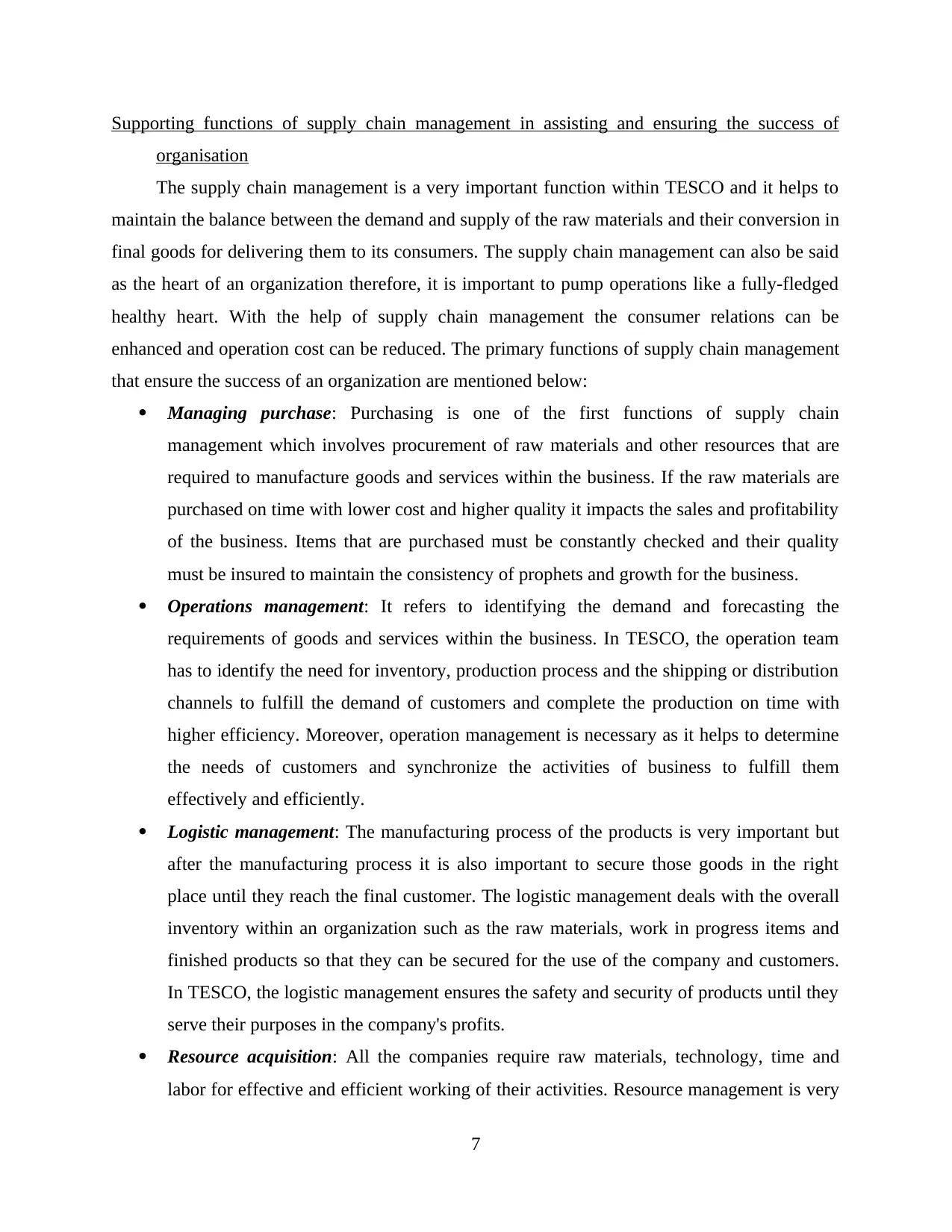
Supporting functions of supply chain management in assisting and ensuring the success of
organisation
The supply chain management is a very important function within TESCO and it helps to
maintain the balance between the demand and supply of the raw materials and their conversion in
final goods for delivering them to its consumers. The supply chain management can also be said
as the heart of an organization therefore, it is important to pump operations like a fully-fledged
healthy heart. With the help of supply chain management the consumer relations can be
enhanced and operation cost can be reduced. The primary functions of supply chain management
that ensure the success of an organization are mentioned below:
Managing purchase: Purchasing is one of the first functions of supply chain
management which involves procurement of raw materials and other resources that are
required to manufacture goods and services within the business. If the raw materials are
purchased on time with lower cost and higher quality it impacts the sales and profitability
of the business. Items that are purchased must be constantly checked and their quality
must be insured to maintain the consistency of prophets and growth for the business.
Operations management: It refers to identifying the demand and forecasting the
requirements of goods and services within the business. In TESCO, the operation team
has to identify the need for inventory, production process and the shipping or distribution
channels to fulfill the demand of customers and complete the production on time with
higher efficiency. Moreover, operation management is necessary as it helps to determine
the needs of customers and synchronize the activities of business to fulfill them
effectively and efficiently.
Logistic management: The manufacturing process of the products is very important but
after the manufacturing process it is also important to secure those goods in the right
place until they reach the final customer. The logistic management deals with the overall
inventory within an organization such as the raw materials, work in progress items and
finished products so that they can be secured for the use of the company and customers.
In TESCO, the logistic management ensures the safety and security of products until they
serve their purposes in the company's profits.
Resource acquisition: All the companies require raw materials, technology, time and
labor for effective and efficient working of their activities. Resource management is very
7
organisation
The supply chain management is a very important function within TESCO and it helps to
maintain the balance between the demand and supply of the raw materials and their conversion in
final goods for delivering them to its consumers. The supply chain management can also be said
as the heart of an organization therefore, it is important to pump operations like a fully-fledged
healthy heart. With the help of supply chain management the consumer relations can be
enhanced and operation cost can be reduced. The primary functions of supply chain management
that ensure the success of an organization are mentioned below:
Managing purchase: Purchasing is one of the first functions of supply chain
management which involves procurement of raw materials and other resources that are
required to manufacture goods and services within the business. If the raw materials are
purchased on time with lower cost and higher quality it impacts the sales and profitability
of the business. Items that are purchased must be constantly checked and their quality
must be insured to maintain the consistency of prophets and growth for the business.
Operations management: It refers to identifying the demand and forecasting the
requirements of goods and services within the business. In TESCO, the operation team
has to identify the need for inventory, production process and the shipping or distribution
channels to fulfill the demand of customers and complete the production on time with
higher efficiency. Moreover, operation management is necessary as it helps to determine
the needs of customers and synchronize the activities of business to fulfill them
effectively and efficiently.
Logistic management: The manufacturing process of the products is very important but
after the manufacturing process it is also important to secure those goods in the right
place until they reach the final customer. The logistic management deals with the overall
inventory within an organization such as the raw materials, work in progress items and
finished products so that they can be secured for the use of the company and customers.
In TESCO, the logistic management ensures the safety and security of products until they
serve their purposes in the company's profits.
Resource acquisition: All the companies require raw materials, technology, time and
labor for effective and efficient working of their activities. Resource management is very
7
⊘ This is a preview!⊘
Do you want full access?
Subscribe today to unlock all pages.

Trusted by 1+ million students worldwide
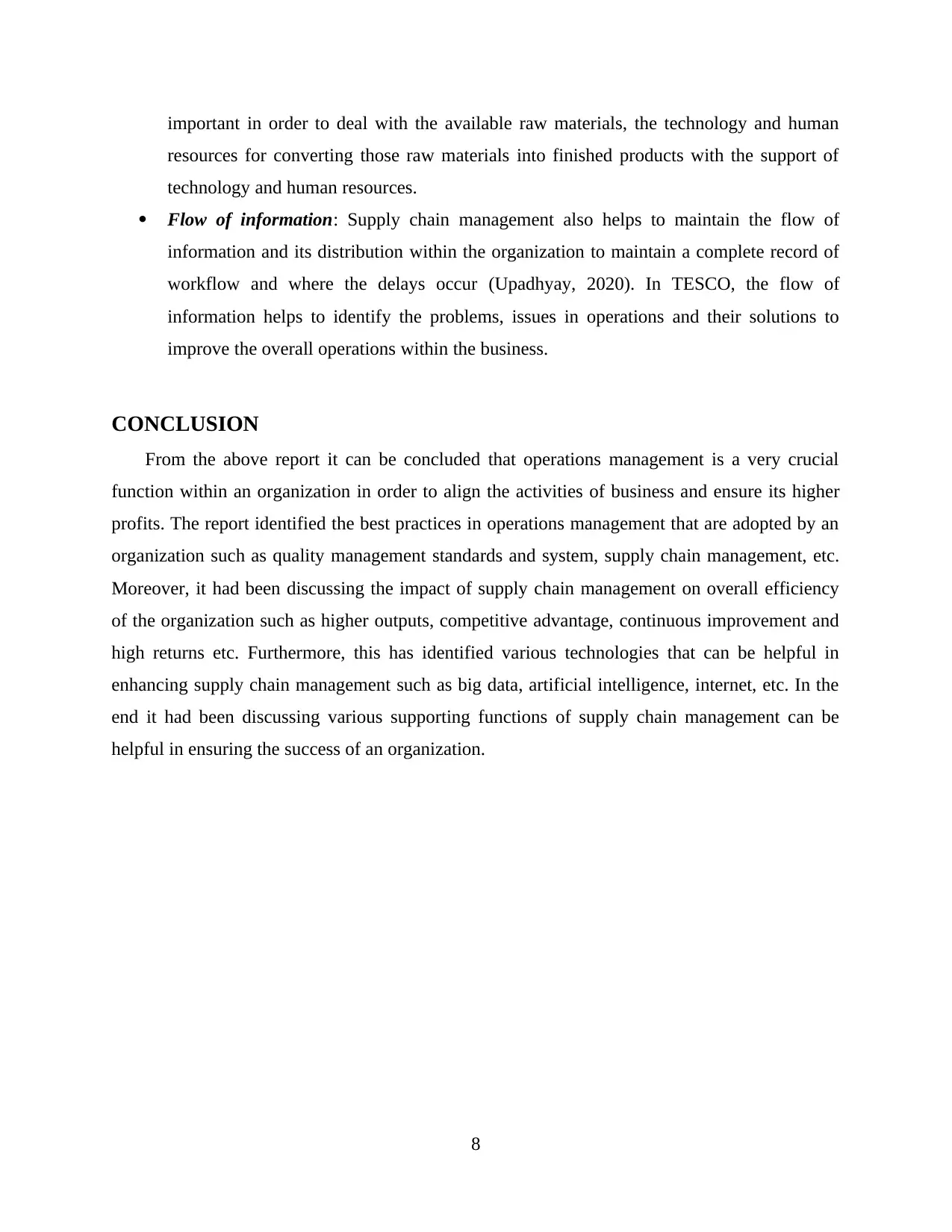
important in order to deal with the available raw materials, the technology and human
resources for converting those raw materials into finished products with the support of
technology and human resources.
Flow of information: Supply chain management also helps to maintain the flow of
information and its distribution within the organization to maintain a complete record of
workflow and where the delays occur (Upadhyay, 2020). In TESCO, the flow of
information helps to identify the problems, issues in operations and their solutions to
improve the overall operations within the business.
CONCLUSION
From the above report it can be concluded that operations management is a very crucial
function within an organization in order to align the activities of business and ensure its higher
profits. The report identified the best practices in operations management that are adopted by an
organization such as quality management standards and system, supply chain management, etc.
Moreover, it had been discussing the impact of supply chain management on overall efficiency
of the organization such as higher outputs, competitive advantage, continuous improvement and
high returns etc. Furthermore, this has identified various technologies that can be helpful in
enhancing supply chain management such as big data, artificial intelligence, internet, etc. In the
end it had been discussing various supporting functions of supply chain management can be
helpful in ensuring the success of an organization.
8
resources for converting those raw materials into finished products with the support of
technology and human resources.
Flow of information: Supply chain management also helps to maintain the flow of
information and its distribution within the organization to maintain a complete record of
workflow and where the delays occur (Upadhyay, 2020). In TESCO, the flow of
information helps to identify the problems, issues in operations and their solutions to
improve the overall operations within the business.
CONCLUSION
From the above report it can be concluded that operations management is a very crucial
function within an organization in order to align the activities of business and ensure its higher
profits. The report identified the best practices in operations management that are adopted by an
organization such as quality management standards and system, supply chain management, etc.
Moreover, it had been discussing the impact of supply chain management on overall efficiency
of the organization such as higher outputs, competitive advantage, continuous improvement and
high returns etc. Furthermore, this has identified various technologies that can be helpful in
enhancing supply chain management such as big data, artificial intelligence, internet, etc. In the
end it had been discussing various supporting functions of supply chain management can be
helpful in ensuring the success of an organization.
8
Paraphrase This Document
Need a fresh take? Get an instant paraphrase of this document with our AI Paraphraser
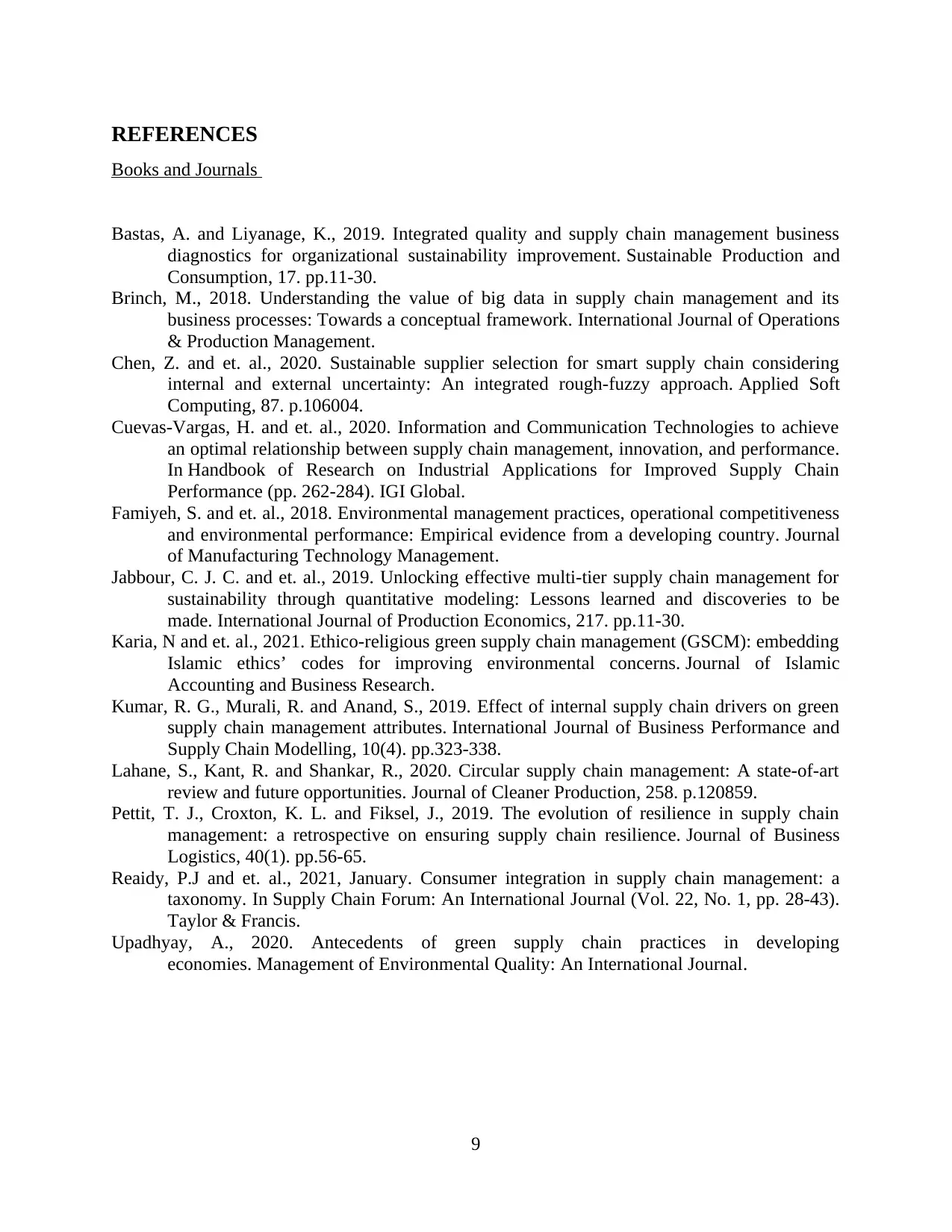
REFERENCES
Books and Journals
Bastas, A. and Liyanage, K., 2019. Integrated quality and supply chain management business
diagnostics for organizational sustainability improvement. Sustainable Production and
Consumption, 17. pp.11-30.
Brinch, M., 2018. Understanding the value of big data in supply chain management and its
business processes: Towards a conceptual framework. International Journal of Operations
& Production Management.
Chen, Z. and et. al., 2020. Sustainable supplier selection for smart supply chain considering
internal and external uncertainty: An integrated rough-fuzzy approach. Applied Soft
Computing, 87. p.106004.
Cuevas-Vargas, H. and et. al., 2020. Information and Communication Technologies to achieve
an optimal relationship between supply chain management, innovation, and performance.
In Handbook of Research on Industrial Applications for Improved Supply Chain
Performance (pp. 262-284). IGI Global.
Famiyeh, S. and et. al., 2018. Environmental management practices, operational competitiveness
and environmental performance: Empirical evidence from a developing country. Journal
of Manufacturing Technology Management.
Jabbour, C. J. C. and et. al., 2019. Unlocking effective multi-tier supply chain management for
sustainability through quantitative modeling: Lessons learned and discoveries to be
made. International Journal of Production Economics, 217. pp.11-30.
Karia, N and et. al., 2021. Ethico-religious green supply chain management (GSCM): embedding
Islamic ethics’ codes for improving environmental concerns. Journal of Islamic
Accounting and Business Research.
Kumar, R. G., Murali, R. and Anand, S., 2019. Effect of internal supply chain drivers on green
supply chain management attributes. International Journal of Business Performance and
Supply Chain Modelling, 10(4). pp.323-338.
Lahane, S., Kant, R. and Shankar, R., 2020. Circular supply chain management: A state-of-art
review and future opportunities. Journal of Cleaner Production, 258. p.120859.
Pettit, T. J., Croxton, K. L. and Fiksel, J., 2019. The evolution of resilience in supply chain
management: a retrospective on ensuring supply chain resilience. Journal of Business
Logistics, 40(1). pp.56-65.
Reaidy, P.J and et. al., 2021, January. Consumer integration in supply chain management: a
taxonomy. In Supply Chain Forum: An International Journal (Vol. 22, No. 1, pp. 28-43).
Taylor & Francis.
Upadhyay, A., 2020. Antecedents of green supply chain practices in developing
economies. Management of Environmental Quality: An International Journal.
9
Books and Journals
Bastas, A. and Liyanage, K., 2019. Integrated quality and supply chain management business
diagnostics for organizational sustainability improvement. Sustainable Production and
Consumption, 17. pp.11-30.
Brinch, M., 2018. Understanding the value of big data in supply chain management and its
business processes: Towards a conceptual framework. International Journal of Operations
& Production Management.
Chen, Z. and et. al., 2020. Sustainable supplier selection for smart supply chain considering
internal and external uncertainty: An integrated rough-fuzzy approach. Applied Soft
Computing, 87. p.106004.
Cuevas-Vargas, H. and et. al., 2020. Information and Communication Technologies to achieve
an optimal relationship between supply chain management, innovation, and performance.
In Handbook of Research on Industrial Applications for Improved Supply Chain
Performance (pp. 262-284). IGI Global.
Famiyeh, S. and et. al., 2018. Environmental management practices, operational competitiveness
and environmental performance: Empirical evidence from a developing country. Journal
of Manufacturing Technology Management.
Jabbour, C. J. C. and et. al., 2019. Unlocking effective multi-tier supply chain management for
sustainability through quantitative modeling: Lessons learned and discoveries to be
made. International Journal of Production Economics, 217. pp.11-30.
Karia, N and et. al., 2021. Ethico-religious green supply chain management (GSCM): embedding
Islamic ethics’ codes for improving environmental concerns. Journal of Islamic
Accounting and Business Research.
Kumar, R. G., Murali, R. and Anand, S., 2019. Effect of internal supply chain drivers on green
supply chain management attributes. International Journal of Business Performance and
Supply Chain Modelling, 10(4). pp.323-338.
Lahane, S., Kant, R. and Shankar, R., 2020. Circular supply chain management: A state-of-art
review and future opportunities. Journal of Cleaner Production, 258. p.120859.
Pettit, T. J., Croxton, K. L. and Fiksel, J., 2019. The evolution of resilience in supply chain
management: a retrospective on ensuring supply chain resilience. Journal of Business
Logistics, 40(1). pp.56-65.
Reaidy, P.J and et. al., 2021, January. Consumer integration in supply chain management: a
taxonomy. In Supply Chain Forum: An International Journal (Vol. 22, No. 1, pp. 28-43).
Taylor & Francis.
Upadhyay, A., 2020. Antecedents of green supply chain practices in developing
economies. Management of Environmental Quality: An International Journal.
9

10
⊘ This is a preview!⊘
Do you want full access?
Subscribe today to unlock all pages.

Trusted by 1+ million students worldwide
1 out of 12
Related Documents
Your All-in-One AI-Powered Toolkit for Academic Success.
+13062052269
info@desklib.com
Available 24*7 on WhatsApp / Email
![[object Object]](/_next/static/media/star-bottom.7253800d.svg)
Unlock your academic potential
Copyright © 2020–2025 A2Z Services. All Rights Reserved. Developed and managed by ZUCOL.




